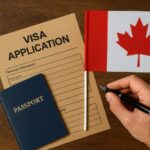
Canada’s Challenge in Removing All Illegal Foreign Nationals: A Complex Issue
The issue of illegal foreign nationals in Canada has become an increasingly complex matter, involving legal, economic, and humanitarian considerations. Thousands of individuals remain in Canada without legal status, and the question arises: Can Canada effectively remove all of them? The answer is not straightforward. Whether under Liberal or Conservative leadership, the task of removing all illegal foreign nationals is viewed as practically impossible. This article explores the numerous factors influencing the situation, backed by data and public sentiment, while discussing the challenges involved in enforcing removals.
Table of Contents
- Understanding “Out of Status” Foreign Nationals
- Canada’s Legal Framework on Removals
- Official Statistics on Illegal Foreign Nationals
- Humanitarian Responsibilities and Obligations
- Public Sentiment and Case Studies
- Cost Implications of Removal
- The Minister’s View on Immigration and Enforcement
- Public Protests and Advocacy for Legalization
- Alternative Solutions to Deportation
1. Understanding “Out of Status” Foreign Nationals
In Canada, individuals are considered “out of status” if they no longer have legal permission to remain in the country. This can happen when someone overstays a visa, works without authorization, or violates the conditions of their stay. The problem is multifaceted:
- Legal Entry but Overstay: Many foreign nationals enter Canada legally but remain beyond the expiration of their visas.
- Violations of Conditions: This includes individuals who work without the proper permits or fail to leave after their authorized stay ends.
2. Canada’s Legal Framework on Removals
The Immigration and Refugee Protection Act (IRPA) governs the removal process and provides different types of removal orders:
- Departure Order: Requires individuals to leave the country within a set period.
- Exclusion Order: Prevents individuals from re-entering Canada for a specific time.
- Deportation Order: Involves permanent removal and bans re-entry.
Furthermore, individuals can appeal their removal orders or apply for permanent residency on humanitarian grounds, considering factors like family ties and hardship if they are sent back to their home countries.
3. Official Statistics on Illegal Foreign Nationals
According to the Canada Border Services Agency (CBSA), there is a significant backlog in removal cases:
- 215,000 Foreign Nationals Awaiting Removal: The backlog includes various categories:
- 120,000 awaiting decisions or further action
- 40,000 who have failed to comply with removal orders
- 55,000 with stays due to legal or humanitarian considerations
In 2023, Canada was able to remove only 5,300 foreign nationals, which shows the difficulties in enforcing removal orders at this scale.
4. Humanitarian Responsibilities and Obligations
Canada’s approach to removals is heavily influenced by humanitarian obligations:
- Refugee Claims: Many individuals who might be out of status have ongoing asylum claims, which can take years to process, during which removal is paused.
- Child Protection: The best interests of children are considered when determining whether to remove families, with permits issued to prevent child separation.
- Family Unity: Efforts to keep families together can influence decisions to allow individuals to stay in Canada.
5. Public Sentiment and Case Studies
There has been growing public support for undocumented foreign nationals. In 2024, 2,500 undocumented workers in Toronto protested, demanding recognition of their contributions to essential sectors like agriculture and construction.
A 2023 poll by the Angus Reid Institute showed that 56% of Canadians support some form of amnesty for undocumented workers, signaling a shift toward more compassionate immigration policies.
6. Cost Implications of Removal
The financial burden of removing individuals without status is substantial:
- Direct Costs: The cost of one removal can range from $5,000 to $15,000, with the higher end reserved for more complex cases that involve detention or international travel.
- Indirect Costs: Legal battles, administrative procedures, and detention costs can significantly increase the total cost of each removal.
- Economic Contributions: Undocumented workers contribute over $7.5 billion annually to the Canadian economy, making their removal a balancing act between legal enforcement and economic benefit.
7. The Minister’s View on Immigration and Enforcement
Immigration Minister Marc Miller has expressed that the government faces challenges in balancing enforcement with compassion. He stated that while Canada must manage its borders responsibly, each case requires careful consideration, reflecting the complexities of immigration policies.
“We must ensure our immigration system reflects both our laws and our values of compassion and inclusion,” said Miller.
8. Public Protests and Advocacy for Legalization
Protests advocating for the regularization of undocumented workers have been ongoing across Canada. Major protests have been held in Montreal, Toronto, and other cities, with thousands rallying for pathways to citizenship or legal status.
Organizations like the Canadian Council for Refugees continue to push for policies recognizing the contributions of undocumented workers, advocating for pathways to legal status or amnesty programs.
9. Alternative Solutions to Deportation
While removal remains a challenge, alternative solutions have been proposed:
- Temporary Resident Permits: These are issued for humanitarian reasons, such as family unity or to avoid harm in the home country. In 2023, 2,400 such permits were granted.
- Regularization Programs: Similar to the one implemented in 1973, which legalized 39,000 undocumented residents, future programs may offer a more permanent solution for undocumented foreign nationals.
- Regionalized Permanent Residency Programs: These programs would focus on retaining workers in rural areas, addressing labor shortages while offering legal status to those who are out of status.
Conclusion: The Road Ahead
The issue of removing illegal foreign nationals is far from simple. It involves a delicate balance between immigration enforcement, humanitarian obligations, and economic considerations. As public opinion shifts towards more compassionate policies, Canada may adopt regularization programs in the future. However, for now, the government faces significant challenges in enforcement, with limited resources and complex legal, diplomatic, and social issues to navigate.
The conversation surrounding the regularization of undocumented foreign nationals is evolving, and it remains to be seen how Canada will balance its immigration laws with its commitment to human rights in the coming years.
For a free consultation about your work permit and student permit options, reach out to the CAD IMMIGRATION today!





